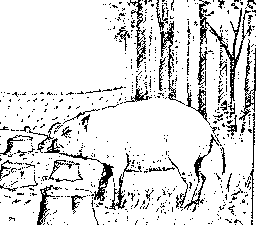 |
Science Frontiers ONLINE No. 66: Nov-Dec 1989 |
|
|
The babirusa: a quasi-ruminant pig
The babirusa, an inhabitant of Indonesia, looks like a thin pig, but its stomach is like that of a sheep, which is a "simple" ruminant. The babirusa's stomach possesses an extra sac; and the animal often browses on leaves and shoots. It does not, however, chew a cud.
 The Indonesian babirusa, a pig-like animal with curious tusks and an unusual digestive system (for a pig). |
The babirusa's "tusks" pose more questions about its evolution:
"The creature's oddest characteristic is the two impressive pairs of curving tusks grown by the males. One pair are simply extended lower canines, but the second are actually upper canines, the sockets of which have rotated, resulting in tusks that grow through the top of the muzzle and emerge from the middle of the animals's face. The effect is bizarre and startling. The males fight with their dagger-like lower canines and probably deflect opponents' blows with the upper set, thus protecting their eyes. Indonesians say the tusks are similar to deer antlers, giving the babirusa its name, which means 'pig deer.'"
(Rice, Ellen K.; "The Babirusa: A Most Unusual Southeast Asian Pig," Animal Kingdom, 91:46, March/April 1988.)
Comment. Turning a pair of teeth 180� in the upper jaw is a fascinating evolutionary accomplishment. It is difficultto-explain on the basis of random mutations, especially in view of the fact that many pigs, with lower tusks only, get along quite well.
Reference. For more on the peculiarities of the babirusa, refer BMA34 and BMF3 in catalog volumes: Biological Anomalies I and II, respectively. These books are described here.